Hello, I’m Michael Zhang—a travel enthusiast from China with a deep passion for exploring the world’s natural wonders and rich histories. Over years of globe-trotting, I’ve developed an eye for uncovering the hidden stories and unique details that make each place truly special. Today, I invite you to join me as we venture into Jiuzhai Valley National Park, often called a “fairyland on Earth.” Here, we’ll discover its stunning landscapes and the vibrant Tibetan culture that thrives amidst its scenic beauty.
Summary
- About Jiuzhai Valley National Park
- Map of Jiuzhai Valley National Park
- Why Visit Jiuzhai Valley National Park?
- Jiuzhai Valley National Park ’s Cultural Heritage
- Things to Do in Jiuzhai Valley National Park
- Explore Scenic Valleys
- Jiuzhai Valley National Park Ticket Guide
- Hiring a Guide in Jiuzhai Valley National Park
- One-Day Tour Planning: The Popular Choice for Most Visitors
- 2-Day, 1-Night Tour Plan: An In-Depth Jiuzhai Valley Experience
- Best Times to Visit Jiuzhai Valley National Park
- Recommended Food in Jiuzhai Valley National Park
- Where to Stay in Jiuzhai Valley
- Two Ways to Travel from Jiuhuang Airport to Jiuzhai Valley
- Three Ways to Travel from Chengdu to Jiuzhai Valley
- Two Ways to Travel from Xi’an to Jiuzhai Valley
- Will I Get Altitude Sickness in Jiuzhai Valley?
- FAQ
About Jiuzhai Valley National Park
Jiuzhai Valley, also known as the Jiuzhaigou National Nature Reserve, is one of China’s most breathtaking destinations. The park is structured around four main scenic areas: Shuzheng Valley, Zechawa Valley, Rize Valley, and Zharu Valley. Renowned for its spectacular karst landscapes, the park boasts vast clusters of high-altitude lakes, cascading travertine waterfalls, and unique calcium-rich formations that create unforgettable water scenes. With over 38 species of climbing plants, 74 nationally protected rare plants, and 122 species of terrestrial vertebrates—including 21 mammal species and 93 bird species—Jiuzhai Valley is as rich in biodiversity as it is in scenic splendor. In December 1992, Jiuzhai Valley earned a prestigious place on UNESCO’s World Heritage List, recognized as an unparalleled natural sanctuary. In 2007, it received the 5A rating, China’s highest tourism standard.
- Location: Located in the Minshan Mountains in northern Sichuan Province. (Apple Maps/Amap)
- Opening Hours: 8:00 AM – 5:00 PM (April 1 – November 15); 8:30 AM – 5:00 PM (November 16 – March 31)
- Recommended Visit Duration: Approximately 1.5 days
- Best Seasons: Jiuzhai Valley’s beauty transcends all four seasons, making it a year-round destination.
- Ticket Purchase: Trip.com Discounts
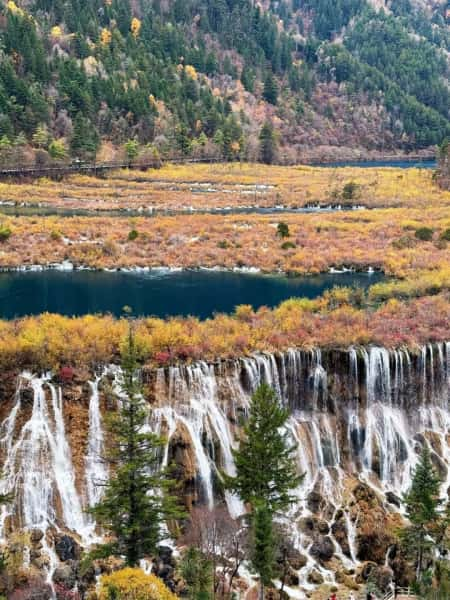
Map of Jiuzhai Valley National Park
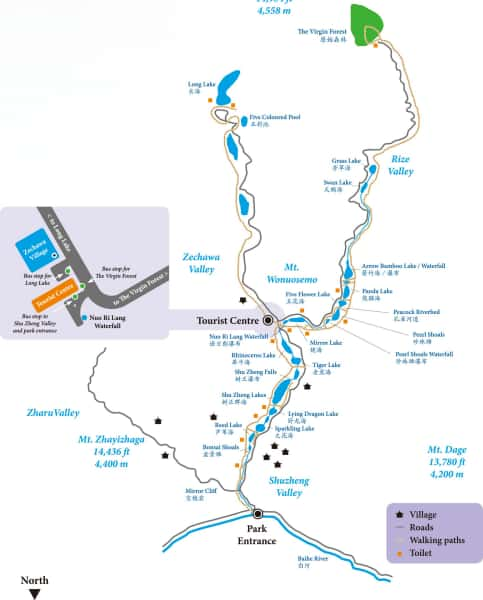
Why Visit Jiuzhai Valley National Park?
Jiuzhai Valley National Park is a masterpiece of nature’s artistry. Encircled by majestic snow-capped peaks, this landscape features pristine, vividly blue lakes, colorful cascading waterfalls, powerful rapids, and lush forests. The brilliant blue skies, warm sunlight, and fresh mountain air combine with ancient Tibetan villages, wooden walkways, and traditional water mills to create a harmonious, picturesque setting that feels like a painting come to life.
Jiuzhai Valley National Park ’s Cultural Heritage
The name “Jiuzhai Valley” (Jiuzhaigou) originates from the nine Tibetan villages within the park: Shuzheng, Zechawa, Heijiao, Heye, Panya, Yala, Jianpan, Rexi, and Guodu, collectively known as the “Nine Villages of Herbal Medicine.” These villages are home to the Tibetan people who have resided here for generations, giving the area its distinct cultural identity.
The Tibetan inhabitants of Jiuzhai Valley primarily follow Bon religion, which arrived in the Aba region around the 2nd century BCE and blended with local shamanistic practices. By the 6th century, Bon was widespread here; however, in the 7th century, Tibetan Buddhism entered the region, challenging Bon’s dominance. Because Bon had deep roots and a strong following in the area, it adapted rather than disappeared, evolving into a unique sect within Tibetan Buddhism and creating a distinctive religious landscape. To this day, Jiuzhai Valley’s cultural traditions retain their strong Tibetan heritage, with elements such as intricate traditional clothing, ceremonial knives, barley wine, butter tea, white khata scarves, lively Tibetan dance, and two-ox plowing.
Things to Do in Jiuzhai Valley National Park
Explore Scenic Valleys
Jiuzhai Valley National Park is divided into three main scenic valleys, each offering a unique experience with countless smaller attractions.
Shuzheng Valley
Shuzheng Valley is the heart of Jiuzhai Valley and the first scenic area visitors encounter. It boasts numerous lakes and waterfalls, including the iconic Shuzheng Lakes, Shuzheng Waterfall, and Tiger Lake. The lake water here is crystal clear and reflects the surrounding green mountains, providing a stunning backdrop for visitors. In sunlight, the water shimmers in shades of blue and green, creating a surreal, dreamlike effect. Shuzheng Lakes form the park’s largest lake cluster, and walking along the lakeside trails reveals breathtaking views of sky and water merging seamlessly. This valley offers both tranquil lakes and awe-inspiring waterfalls, making it an essential part of any Jiuzhai Valley visit.
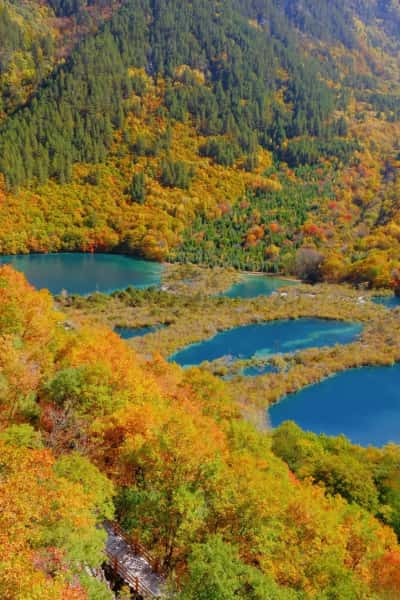
Zechawa Valley
Known for its enchanting lakes and waterfalls, Zechawa Valley’s highlights include Long Lake and Five-Color Pond. Long Lake is the largest lake in Jiuzhai Valley, with expansive blue waters surrounded by towering mountains—an ideal spot for photography. Nearby, Five-Color Pond showcases a rainbow of hues caused by its unique mineral composition. In autumn, the surrounding foliage turns vibrant shades of red, yellow, and orange, contrasting beautifully with the lake’s turquoise waters. This valley is serene yet full of energy, offering a captivating, immersive experience.
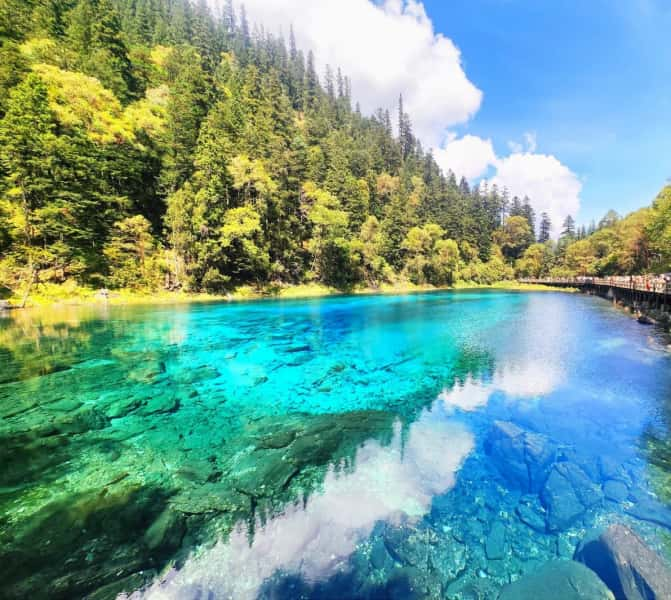
Rize Valley
Rize Valley is Jiuzhai Valley’s most concentrated scenic area, celebrated for its stunning waterfalls and lakes. Must-visit spots include Nuorilang Waterfall, Pearl Shoal, and Five Flower Lake. Nuorilang Waterfall, the park’s largest, is a powerful cascade, with water plunging down and creating a mist that adds to its grandeur. Pearl Shoal features water gliding over a shallow stream bed, appearing like bouncing pearls on the surface—pure, dynamic beauty. Five Flower Lake, with its mineral-rich waters, displays a brilliant array of colors, making it a top scenic highlight. Rize Valley embodies the essence of Jiuzhai Valley, especially appealing to photographers and those seeking a deeper connection with nature.
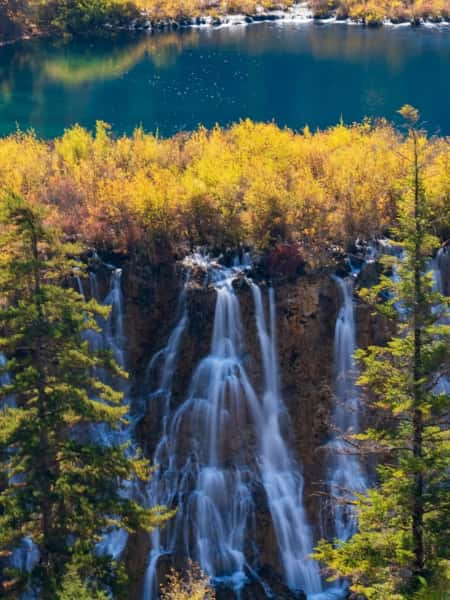
Jiuzhai Valley National Park Ticket Guide
Admission Prices
- Off-Peak Season (November 16 – March 31)
- Ticket Prices: Adults ¥80, children ¥40, students ¥40 (for ages 15-18, no student ID needed; university students must show student ID), seniors ¥40.
- Free Entry: Children 6 years and younger.
- Entry Hours: 8:30 AM to 2:00 PM (entry required by 2:00 PM on the same day).
- Peak Season (April 1 – November 15)
- Ticket Prices: Adults ¥190, children ¥95, students ¥95 (for ages 15-18, no student ID needed; university students must show student ID), seniors ¥95.
- Free Entry: Children 6 years and younger.
- Entry Hours: 7:30 AM to 2:00 PM (entry required by 2:00 PM on the same day).
- Ticket Purchase: Trip.com Discounts
Sightseeing Shuttle Tickets
Jiuzhai Valley’s shuttle bus service allows unlimited rides, helping visitors conserve energy while exploring the park’s highlights.
- Off-Peak Season (November 16 – March 31)
- Ticket Prices: Adults ¥80, children ¥40, students ¥80, seniors ¥80.
- Free Entry: Children 6 years and younger.
- Peak Season (April 1 – November 15)
- Ticket Prices: Adults ¥90, children ¥45, students ¥90, seniors ¥90.
- Free Entry: Children 6 years and younger.
Purchasing Options
- Online: Tickets are available through online travel platforms.
- Ticket Purchase: Trip.com Discounts
- Onsite: Tickets can also be purchased at the park’s service center near the entrance. Be sure to bring valid identification.
Hiring a Guide in Jiuzhai Valley National Park
While Jiuzhai Valley National Park has no official tour guides, its natural attractions are well-marked and easy to navigate for independent travelers. However, for a deeper understanding of Jiuzhai Valley’s cultural and Tibetan heritage, hiring a local guide is highly recommended. You can book a guide through reputable online travel platforms; avoid extremely low-cost tours to ensure quality and a meaningful experience.
One-Day Tour Planning: The Popular Choice for Most Visitors
Departing from Chengdu
- 6:45 AM – Board the earliest high-speed train from Chengdu East Station. The ride takes about 2 hours.
- 8:45 AM – Arrive at Jiuzhai Valley train station. Outside the station, there are buses to both Jiuzhai Valley National Park and Huanglong. Board the bus, purchase your ticket, and depart once the bus is full.
- 10:30 AM – Arrive at Jiuzhai Valley National Park. After entering, you can take the shuttle bus within the park, with unlimited rides to explore at your own pace.
- 12:00 PM – Visit popular scenic spots like Pearl Shoal, Long Lake, and Five-Color Pond. Long Lake and Five-Flower Lake are situated farthest on the park’s left side and are Jiuzhai Valley’s iconic lakes.
- 3:15 PM – Walk to the shuttle bus departure point near the park entrance (approximately a 1000-meter walk). It’s wise to reserve return bus tickets in advance, as bus departures align closely with train schedules.
- 3:30 PM – Board the shuttle bus back to the train station.
- 6:20 PM – Take the high-speed train back to Chengdu East Station, another 2-hour ride.
Tour Route Starting from Jiuzhai Valley National Park
Morning – Begin with Zechawa and Rize Valleys:
- Take the shuttle bus into the valleys, alighting at Nuorilang Center Station.
- Transfer to the Zechawa Valley shuttle and travel to Long Lake. Walk to Five-Color Pond, where you can admire its vibrant waters.
- From Five-Color Pond, return to Nuorilang Center Station and transfer to Rize Valley.
Noon – Lunch at Nuorilang Restaurant.
Afternoon – Continue exploring Rize and Shuzheng Valleys’ core attractions:
- Ride to the end of Rize Valley, the Virgin Forest. Without getting off, head back and stop at Arrow Bamboo Lake to start the scenic trek from Arrow Bamboo to Mirror Lake, which showcases the best of Rize Valley.
- Back at Nuorilang Center Station, walk to Nuorilang Waterfall, one of the park’s most spectacular waterfalls.
- Return to Nuorilang Center, then take the shuttle to Rhino Lake. From there, walk to Bonsai Shoal in Shuzheng Valley, a scenic stretch showcasing Jiuzhai Valley’s signature features.
- After sightseeing, board the shuttle to exit the park, concluding your one-day visit.
2-Day, 1-Night Tour Plan: An In-Depth Jiuzhai Valley Experience
Day 1: Depart from Chengdu and Arrive in Jiuzhai Valley
- Morning – Take the high-speed train from Chengdu East Station to Jiuzhai Valley. Try to catch an early train to arrive before noon.
- Noon – After arriving, start with a hearty meal of traditional yak hot pot—a great energy boost for the afternoon.
- Afternoon – Choose to either relax at the hotel and acclimate to the altitude or explore Zhongcha Valley nearby. Known for its vast grasslands and Tibetan culture, Zhongcha Valley offers horseback riding and stunning mountain views.
- Evening – Dive into Tibetan culture with a local dinner. Sample qingke barley wine, butter tea, and Tibetan hot pot, which together offer an authentic taste of regional cuisine.
Day 2: Deep Dive into Jiuzhai Valley’s Scenic Spots and Return to Chengdu
- Morning – Arrive at the park’s entrance by 9:00 AM. Consider storing any extra luggage for easier mobility throughout the day.
- Late Morning – Begin exploring Jiuzhai Valley’s main scenic areas by shuttle bus, covering Zechawa Valley and Rize Valley. Start at Nuorilang Center Station, then head to Long Lake in Zechawa Valley. Walk along the scenic trail to enjoy the colors of Five-Color Pond.
- Noon – Break for lunch at Nuorilang Restaurant within the park.
- Afternoon – Continue to Shuzheng and Rize Valleys, which feature some of Jiuzhai Valley’s most iconic landscapes. In Rize Valley, visit Arrow Bamboo Lake, Mirror Lake, and Nuorilang Waterfall. This segment offers spectacular views and easy photography opportunities.
- Later, follow the trail along Rhino Lake and Bonsai Shoal in Shuzheng Valley. This stretch, rich with unique lakes and waterfalls, captures the essence of Jiuzhai Valley.
- 5:00 PM – Exit the park and enjoy dinner near Jiuzhai Valley before heading back to the high-speed train station.
- Evening – Take the train back to Chengdu, concluding a memorable 2-day Jiuzhai Valley journey.
Best Times to Visit Jiuzhai Valley National Park
Spring: Blossoms and the Tu Mo Festival
From mid-March to mid-April, Jiuzhai Valley bursts with spring flowers, especially near the park entrance, Reed Lake, Spark Lake, and Tiger Lake. This is the best time to see wildflowers in bloom. On the 16th day of the Tibetan lunar calendar, locals celebrate the annual Tu Mo Festival in Caodi Village, where the Baima Tibetan people light bonfires, dance the “Ring of Fire,” and sing traditional songs—offering a rare glimpse into their unique cultural traditions.
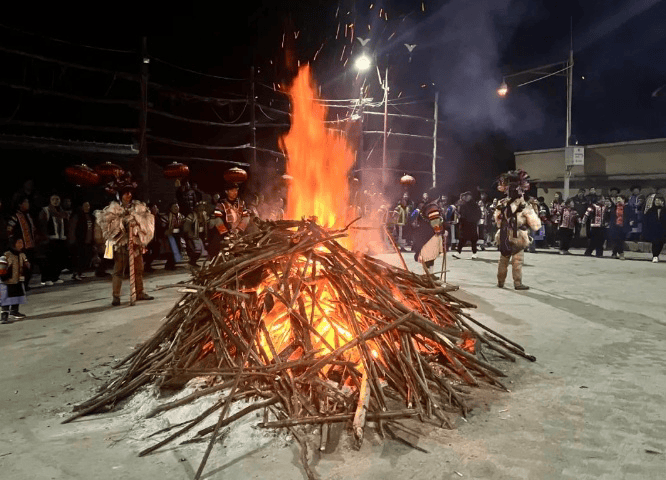
Summer: Waterfalls in Full Flow and a Cool Escape
Summer (June through August) is peak water season in Jiuzhai Valley, when waterfalls flow at their fullest and lakes are at their most vibrant. The park’s lush vegetation and clear blue lakes create a refreshing oasis, with cool temperatures ideal for hiking and photography. Summer visitors can capture scenes of sparkling blue lakes and sky reflecting off the water, making Jiuzhai Valley an ideal destination for both nature lovers and those seeking to escape the heat.
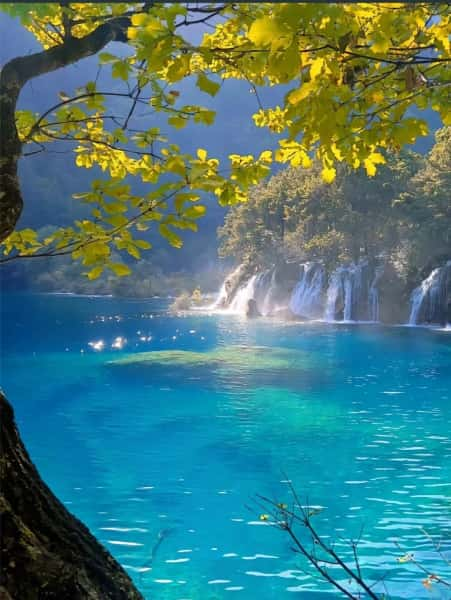
Autumn: Mountains Cloaked in Red and Gold
Autumn (September through November) is Jiuzhai Valley’s most colorful season, as its forests turn vibrant shades of yellow, orange, and deep red:
- Late September to Early October: Leaves start to turn yellow, marking Level I of the “Red Leaf Index” (10%-35% color change) and offering a gentle introduction to the fall colors.
- Mid-October to Late October: Leaves reach Level II on the index (35%-60% color change), displaying bright reds, yellows, and oranges for an ideal viewing experience.
- Late October to Early November: The foliage peaks at Level III (60%-95% color change), with deep reds and purples—this is Jiuzhai Valley’s autumn scenery at its best.
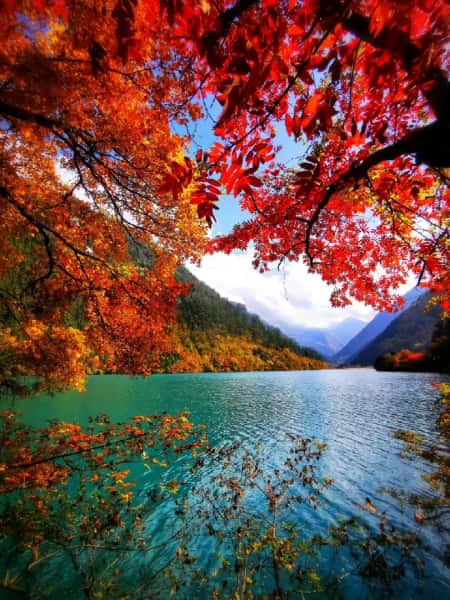
Winter: A Snow-Covered Fairyland
Winter (December through February) transforms Jiuzhai Valley into a snowy wonderland, with frozen lakes and snow-draped forests and mountains. The lake surfaces glisten like blue gems under the snow, creating a serene and magical atmosphere. Winter in Jiuzhai Valley offers a unique, tranquil experience with stunning vistas and a sense of peace that’s hard to match.
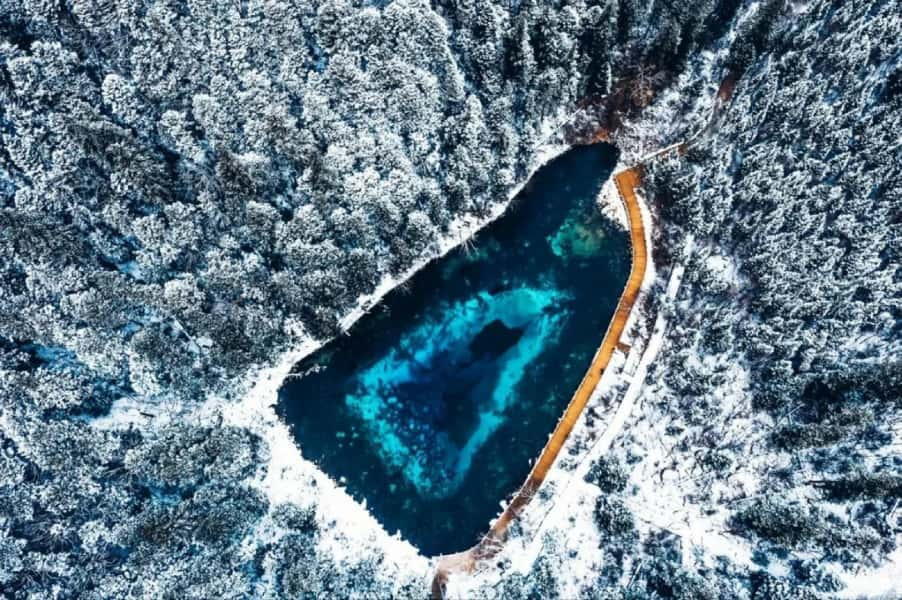
Recommended Food in Jiuzhai Valley National Park
Inside Jiuzhai Valley Park
- Nuorilang Restaurant
- Boxed Meal Options:
- ¥25: Wood ear mushrooms with pork + Mapo tofu
- ¥30: Homestyle chicken + wood ear mushrooms with pork + Mapo tofu
- ¥40: Braised pork + sausage + wood ear mushrooms (varies daily)
- Buffet: ¥60 per person
- Noodle Dishes: ¥30, with options like Jiuzhai zhajiang noodles (with red or clear broth) and braised yak beef noodles
- Conveniently located at the park’s transfer station, Nuorilang Restaurant offers simple boxed meals and a buffet, perfect for a quick and energizing meal between scenic stops.
- Boxed Meal Options:
- Snack Shops
- Grilled sausage: ¥5-10 each, a hot snack to enjoy on the go
- Instant noodles: ¥15 per cup
- Self-heating rice meals: ¥30 per box
- Soft bread: ¥15 per pack
- The snack shops within the park offer convenient, portable treats for hikers to enjoy during a break in the park’s stunning surroundings.
Outside Jiuzhai Valley Park
- Himalaya Music Tibetan Restaurant
- Location: Second floor, near the Fan Shan Li Jing Hotel on Bar Street
- Price: Around ¥120 per person
- Why Go: This lively restaurant embodies Tibetan culture, with live performances of traditional songs by the owner. It’s an authentic place to experience local culture.
- Specialties:
- Yak Meat with Potatoes: Juicy, tender yak meat over golden-fried potatoes served with soft, flavorful flatbreads for a balanced, rich taste.
- Roast Lamb Ribs: Crisp outside, tender inside, and served with a special garlic dipping sauce for a unique flavor combination.
- Yogurt + Ice Cream: Creamy and full of flavor, it’s a must-try dessert.
- Butter Tea: A classic Tibetan drink, this savory milk tea made from butter, brick tea, and salt is rich in nutrients and an essential part of Tibetan dining culture.
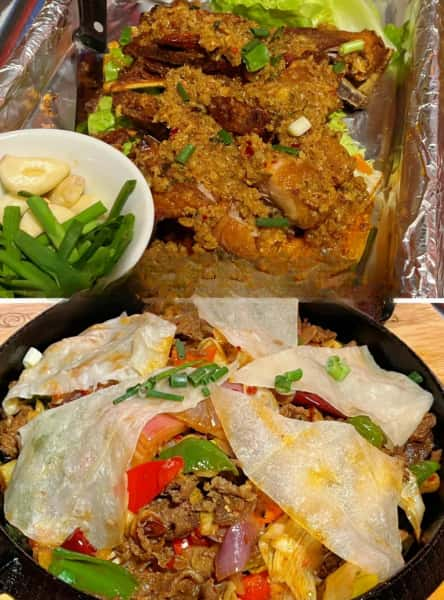
- Jiuzhai Yak Hot Pot Restaurant
- Location: 63 Pengfeng Village, Group 2, on National Road 544
- Price: Around ¥80 per person
- Why Go: Close to the park entrance, this spot is popular for authentic yak hot pot, known for its friendly service and great reviews.
- Specialties:
- Wild Mushroom and Beef Hot Pot: A hearty, earthy mushroom broth with chewy beef, served with a special dipping sauce that enhances the rich flavor.
- Crispy Fried Pork: Tender and crispy, with a hint of Sichuan pepper for added kick, this local snack is a flavorful delight.
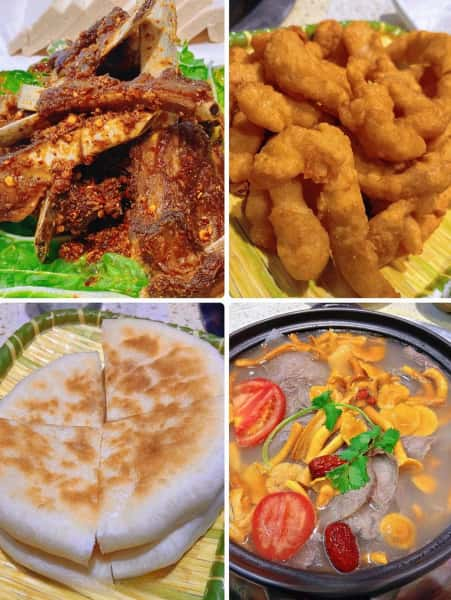
Where to Stay in Jiuzhai Valley
Hotels Near the Park Entrance
These hotels are highly recommended for their convenience, located within a 3-15 minute walk to the park entrance. Each offers a range of amenities, and being close to the park is their primary advantage.
- Jiuzhai Valley VIP Hotel: ¥1000/night
- Howard Johnson Tianyuan Resort Jiuzhaigou: ¥550/night
- Ji Hotel (Jiuzhaigou Scenic Area): ¥650/night
- Jiuzhai Valley Li Cheng Hua Ting Resort Hotel: ¥400/night
Luxury Options in Luneng Town
For those seeking the utmost in comfort and service, Luneng Town hotels offer unmatched amenities. However, these are located farther from the park, requiring a taxi ride.
- The Ritz-Carlton Reserve Jiuzhaigou: ¥10,000/night
- Conrad Jiuzhaigou: ¥1300/night
- Hilton Jiuzhaigou Resort: ¥1000/night (best value)
Two Ways to Travel from Jiuhuang Airport to Jiuzhai Valley
Jiuhuang Airport is approximately 88 km (55 miles) from Jiuzhai Valley National Park, with a travel time of about 1.5 to 2 hours. Here are two convenient options for reaching the park:
1. Take the Airport Shuttle Bus (Recommended)
- Route: Jiuhuang Airport offers direct shuttle bus service to Jiuzhai Valley National Park. Buses usually depart shortly after flight arrivals, and the schedule is adjusted according to flight timings.
- Cost: ¥50 per person
- Duration: About 1.5 to 2 hours
- Highlights: This shuttle takes you directly to the park’s entrance, making it ideal for solo travelers or small groups.
- Operating Hours: First departure aligns with the day’s first arriving flight; the last bus leaves at 7:30 PM.
2. Take a Taxi
- Cost: Around ¥200-300 per car
- Duration: Approximately 1.5 hours
- Highlights: A taxi offers the quickest, most direct route and is ideal for travelers with more luggage or those sharing the cost with companions. Taxis are available directly outside the airport’s taxi stand.
- Operating Hours: 24/7 availability
Three Ways to Travel from Chengdu to Jiuzhai Valley
The distance between Chengdu and Jiuzhai Valley National Park is about 330 km (205 miles). Here are three popular ways to make the journey:
1. High-Speed Train + Shuttle Bus (Recommended)
- Route: Chengdu East Station → Jiuzhai Valley Station (high-speed train) → Park shuttle bus
- Travel Time: Approximately 2 hours by train, then 1.5 hours by shuttle bus
- Cost: Train tickets around ¥150, shuttle bus around ¥30-50
- Highlights: High-speed trains provide the fastest option, departing from Chengdu East Station. Once at Jiuzhai Valley Station, dedicated buses transport travelers directly to the park. This route is best for those on a tight schedule.
2. Flight + Airport Shuttle/Taxi
- Route: Chengdu Shuangliu International Airport or Tianfu International Airport → Jiuhuang Airport (flight) → Airport shuttle bus/taxi
- Travel Time: About 1 hour by air; then 1.5-2 hours from the airport to the park
- Cost: Flights vary by season (¥500-1500), shuttle bus ¥45-50, taxi ¥200-300
- Highlights: After flying to Jiuhuang Airport, travelers can choose either the shuttle bus or a taxi to reach Jiuzhai Valley. Ideal for those who prioritize speed and convenience, though flight prices may be higher during peak season—so book in advance if possible.
3. Direct Bus
- Departure Points: Buses to Jiuzhai Valley depart from Chengdu’s Xinnanmen Bus Station or Chadianzi Bus Station.
- Travel Time: Approximately 8-10 hours
- Cost: About ¥150-200
- Highlights: Several direct buses run daily in the morning and afternoon, making this an affordable option. However, the trip is long, and buses typically make stops at rest stations along the way. This option suits budget-conscious travelers comfortable with extended travel times.
Two Ways to Travel from Xi’an to Jiuzhai Valley
The distance from Xi’an to Jiuzhai Valley is about 600 km (370 miles). Here are two convenient options:
1. Flight + Airport Shuttle or Taxi
- Route: Xi’an Xianyang International Airport → Jiuhuang Airport (flight) → Airport shuttle or taxi
- Travel Time: Approximately 1 hour by flight; 1.5-2 hours from Jiuhuang Airport to Jiuzhai Valley
- Cost: Flights vary by season (around ¥600-1500); airport shuttle ¥50, taxi around ¥200-300
- Highlights: Flying from Xi’an to Jiuhuang Airport is the fastest way to reach Jiuzhai Valley. After landing, you can take the airport shuttle or a taxi to the park. Since tickets are in high demand during peak season, booking in advance is recommended.
2. High-Speed Train + Bus
- Route: Xi’an North Station → Guangyuan Station (high-speed train) → Bus to Jiuzhai Valley
- Travel Time: About 2 hours by train, then approximately 5 hours by bus
- Cost: Train fare around ¥120; bus fare around ¥100-150
- Highlights: The high-speed train from Xi’an North to Guangyuan is quick and comfortable. From Guangyuan, you can transfer to a bus or arrange for a car to Jiuzhai Valley. This route is ideal for travelers with more flexible schedules.
Will I Get Altitude Sickness in Jiuzhai Valley?
Most visitors to Jiuzhai Valley (elevation around 2,000-3,100 meters) experience little to no altitude sickness. The altitude here is moderate, but sensitive individuals might feel mild symptoms such as dizziness, slight headache, or fatigue.
If you’re concerned about altitude sickness, here are some helpful tips:
- Stay Hydrated: The air is dry at higher altitudes, so drink plenty of water to prevent dehydration.
- Avoid Strenuous Activity: During your first day, avoid overexertion to help your body acclimate.
- Energy-Boosting Snacks: Carrying some candies, nuts, or small snacks can help keep your energy up.
- Limit Alcohol: Minimize alcohol intake as it can accelerate dehydration and increase the risk of altitude sickness.
- Pack Medication: Consider bringing altitude sickness medication and a portable oxygen canister, especially if you’re prone to altitude issues.
FAQ
Is there a multi-day ticket option?
Currently, Jiuzhai Valley does not offer multi-day tickets. Visitors planning to tour the park over two days must purchase a new ticket each day. Additionally, shuttle tickets need to be purchased daily.
Where can I store my luggage?
Once you enter the park’s visitor center, head left toward the “Pure Land Aba” store. Walk another 10 meters, and you’ll find a simple storage room with shelves. Obtain a tag from the staff, write your phone number on it, and attach it to your luggage before leaving it on the shelf for convenient storage.
Are drones allowed in the park?
Drones are not permitted in Jiuzhai Valley National Park. Surveillance and patrol personnel monitor the park to ensure safety and protect the environment.

 English (US)
English (US)
 繁體中文
繁體中文 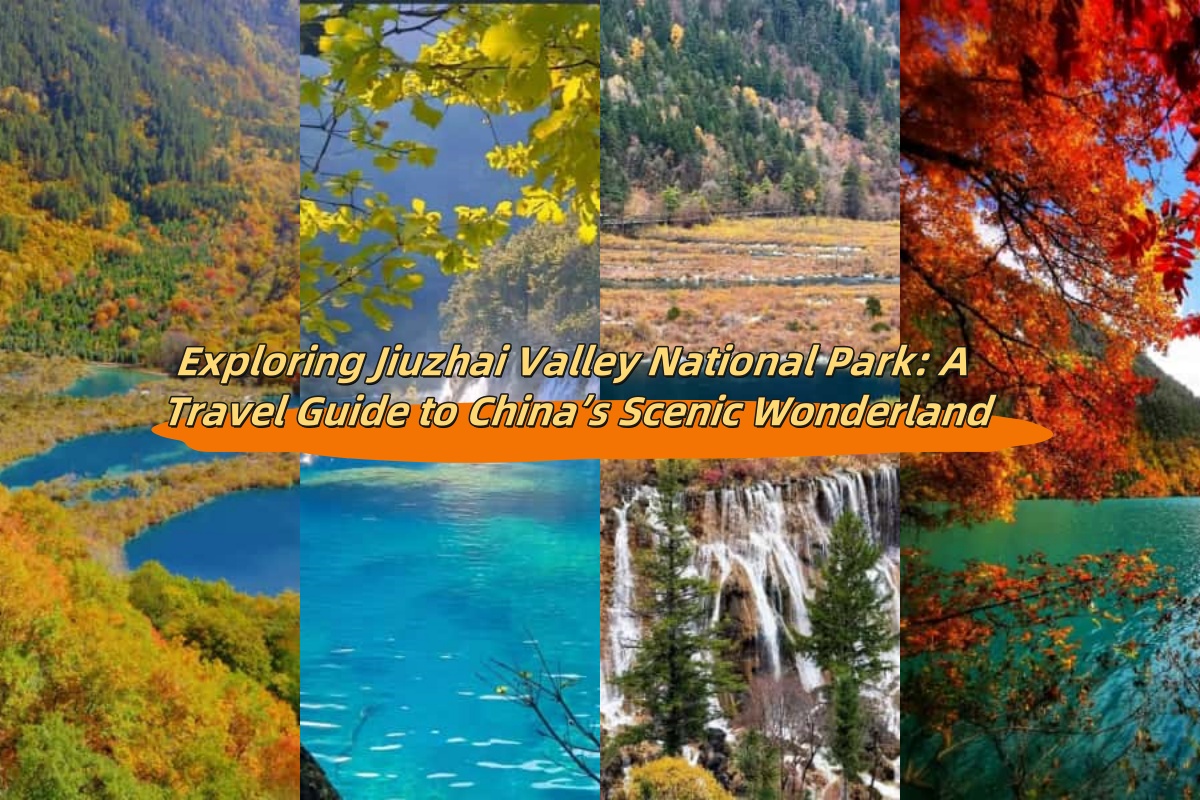
Comment (0)